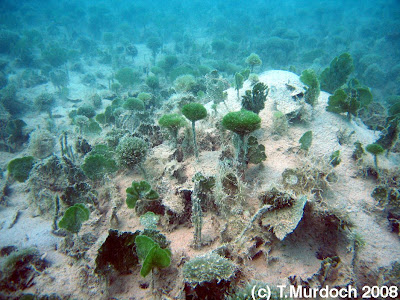Green Calcareous Macroalgae
Green Calcareous Macroalgae are a group of plants that grow in sandy and silty areas on the sea floor where water flow from currents or waves is very low. Several genera of plants are found in Bermuda, including:
Udotea, which looks kind of like a ping ping paddle,
Penicillus, otherwise known as Merman's Shaving Brush,
Halimeda, which look like little trees,
Acetabularia, otherwise known as Mermaid's wine glass.
These plants often grow in meadows in deeper harbours and sandy basins between the coral reefs in the lagoon. While they receive little attention they provide an important habitat for juvenile and adult fishes, as well as provide substrate for epiphytic (meaning "living on a plant") plants and animals. Additionally animals that live in the sand (termed "infauna") are generally abundant around calcareous macroalgae beds.
Fortunately, benthic surveys by Dr. Sarah Manuel, Dr. Kathy Coates and Anson Nash of the Department of Conservation Services are providing the first lagoon-wide maps of the distribution of these important but under-appreciated plants.



Comments